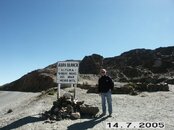Hi all, I've been reading the book Diving Science by Michael B. Strauss, MD and Igor V. Aksenov, MD PhD.
It mentions that our lungs are capable of handling an oxygen partial pressure from 0.158 to 2 ATAs.
Looking at the table of Atmospheric Pressure as a function of altitude, at 2,350 meters high (7,710 feet) the Atmospheric Pressure is 0.752 ATA and oxygen partial pressure is 0.158 ATA. If we go higher, we are exposed to hypoxia.
I remember to have spent a whole day at an altitude of 4.080 meters, where the Atmospheric Pressure was 0.6 ATA, which corresponds an oxygen partial pressure of 0.126 ATA, and I was OK, no oxygen required.
How long can a human being be at that altitude without the need of additional oxygen supply ?
I think that things are no so linear or easy. I should be missing something.
It mentions that our lungs are capable of handling an oxygen partial pressure from 0.158 to 2 ATAs.
Looking at the table of Atmospheric Pressure as a function of altitude, at 2,350 meters high (7,710 feet) the Atmospheric Pressure is 0.752 ATA and oxygen partial pressure is 0.158 ATA. If we go higher, we are exposed to hypoxia.
I remember to have spent a whole day at an altitude of 4.080 meters, where the Atmospheric Pressure was 0.6 ATA, which corresponds an oxygen partial pressure of 0.126 ATA, and I was OK, no oxygen required.
How long can a human being be at that altitude without the need of additional oxygen supply ?
I think that things are no so linear or easy. I should be missing something.





